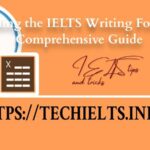You can do well on IELTS Writing Task 1 with this help. You can do well on this important part of the IELTS test by reading this blog post. It has helpful information, tips, and tricks. Learn IELTS Writing Task 1 if you want to reach your goals, whether you’re a student who wants to study abroad or a worker who wants to get better at academic writing. Let’s start by going over everything you need to know for this part!
Understanding IELTS Writing Task 1
One of the most important parts of the IELTS test is Task 1. It checks how well you can remember things and write about them. As part of the Academic part of the IELTS test, you have to do this part. It checks how well you can write for school. For this job, you need to write an answer that is clear and to the point based on the graphs, charts, maps, and lists of visual data you look at. The IELTS Writing Task 1 is very important because it tests your writing skills. You will need them for school and for work.

Importance of IELTS Writing Task 1 for Academic module
Writing Task 1 is a very important part of the IELTS. This is very important for kids who want to go to college. Test marks from the IELTS are used all over the world to see how well people can speak and write English. How well you do on Writing Task 1 will show how well you can explain, understand, and analyse visual data. For school, this is a useful skill.
Writing Task 1 also helps you get ready for the kinds of writing you’ll have to do in school. You learn useful skills like how to read and understand data, put together different pieces of information, and write clearly. These skills come in handy in many work and school situations.
You can get into the school of your choice if you do well on IELTS Writing Task 1. It will also help you do well on other tasks by making your writing better in general.
Scoring Criteria for IELTS Writing Task 1
You need to know how to score on IELTS Writing Task 1 if you want to get a high band score. The judges decide how to grade your answer based on certain factors. These are some of the most important things they check:
job Well done: Achieving a task is all about how well you meet the needs of the job and give a clear picture of the visual data. You will get a grade based on how well you can describe the main points, features, and trends.
If your thoughts make sense and flow together, they are said to be coherent. This makes sure that the information is clear. Being cohesive means that the different parts of your answer flow together well. Some examples of this are linked words, pronouns, and references. When a piece is well-structured, organised, and simple to read, it makes sense and flows together well.
c. The Lexical Resource: This tool checks what you know and how you use words. Testers look for a wide range of words, the right ones to use, and the ability to use words that deal with graphs, charts, maps, and understanding what data means. Your work will be clearer and more correct if you use a lot of different words.
There are two types of grammar tests: grammar range and accuracy. Grammar range checks how many different sentence types, tenses, and grammar rules you use. It can be harder to write when you know a lot of different kinds of language. On the other hand, if you use language properly, you won’t make mistakes and your writing will make sense.
You can meet the examiner’s expectations and get a better band score on Writing Task 1 if you pay attention to these key parts and understand these marking factors.
Key Components of IELTS Writing Task 1
You need to know the main points of IELTS Academic Writing Task 1 in order to do well on it. The British Council’s eBooks and PDFs are great ways to get better at this job. If you are taking the IELTS test for school or for fun in Australia, India, Canada, China, the UK, Germany, France, or Spain, these tools can help you. People taking the IELTS can also find help on blogs and through email. This helps people get ready for any test and do well on it.
Task Achievement and Task Response
To conclude the job, you must satisfy its goals and provide a complete summary. Correctly explaining specific information and essential features is crucial to meeting task answer requirements. A review paragraph should be concise, to the point, and provide only the most significant details without going into too much detail. To pass the IELTS Academic Writing Task, you must know the facts and summarise them in one paragraph.
Coherence and Cohesion
Coherence and harmony are critical for a well-structured and put-together answer. When writing, it is critical that the thoughts and information flow smoothly and make sense. Coherence and organisation improve when linking words and other mechanisms that keep things together are used. It is also critical to utilise proper paragraphing to keep the content flowing smoothly. If you employ cohesive devices correctly, you can be certain that the solution will be coherent and cohesive.
Lexical Resource
This is the Academic Writing Task in IELTS. If you want to achieve a high band score, you must demonstrate that you know a lot and can apply it correctly. When discussing graphs, charts, and maps, it is preferable to utilise a variety of words to describe patterns and essential aspects. You can also demonstrate your vocabulary strength by employing specific terms, paraphrase, and synonyms. If you wish to take the IELTS test in Australia, India, or anyplace else, you must know how to use words correctly. You may discover new words and improve your IELTS writing skills by using our free guide and blog.
Grammar Range and Accuracy
If you apply a variety of grammar patterns, your work will be more engaging and demonstrate that you are very strong at grammar. The use of right terminology is essential for consistency and cohesiveness. This contributes to a clear and flowing writing style. If you employ the proper tenses, sentence structures, and punctuation, your work will be more fascinating. Using a variety of sentence patterns and types will also aid in your language improvement. You must utilise good grammar throughout your answer to get a high degree of grammatical competency.
Basic Structure of IELTS Writing Task 1
For IELTS Writing Task 1, you must understand how a basic framework works, including an introduction, a plan, and specifics. If you want to get the information across, you must be familiar with the essential aspects of the job, such as key specifics, major trends, and comparisons. If you understand the fundamental structure, you can be confident that your response is well-organized. This will assist you in writing a coherent and well-developed academic work. You can be confident in your prospects of landing a job if you understand how the system works, regardless of whether you are taking the IELTS academic test or a general training test from the British Council, IDP, or Cambridge.
Tips for effective structure
When writing for IELTS task 1, start with a brief introduction that restates the question. Following that, the most essential aspects of the visual data you presented should be highlighted in your summary text. As you compose the main body lines, keep the outline you provided previously in mind. For your answer to be clear and make sense, it must be well-organized and have a clear flow of thoughts. Remember that a good overview and detailed details are the keys to a well-structured response.
Example of a well-structured response
When writing a well-organized answer for the IELTS academic writing task, it’s important to give a clear summary and talk about the most important points. The main points should be carefully thought through and backed up by relevant facts. It is important to be able to compare, contrast, and show trends clearly so that information flows smoothly and there is a clear conclusion. To get a high band score on the general training or academic test in IELTS test centres in Australia, India, Canada, China, the UK, Germany, or France, you must strictly follow the task achievement standards. It can be very helpful to get reading materials like ebooks, PDFs, or official blogs from the British Council, the IDP, or even in Ireland and Spain.
Types of Graphs in IELTS Writing Task 1
Some of the graphs you might see in IELTS Writing Task 1 are pie charts, bar charts, process charts, maps and flowcharts. There are different ways to show each type of material and the right words and structures to use to describe them. To get a high band score on the IELTS, you need to know how each type of graph is different. You can also show and understand data better on both the IELTS Academic and General Training tests if you know how to use the different kinds of plots.
Understanding Graphs
It’s very important to correctly interpret statistics if you want to understand plots. To better understand, it’s helpful to know what the graph’s key parts and trends are. To finish the job, you need to be very clear when you talk about the main points. When writing, it’s also important to use the right words and make sense so that the graph is easy to understand. You need to know how to answer different types of questions in order to read and understand plots.
Mastering Pie Charts
You need to be able to compare the different parts of a pie chart well in order to understand them. Really know how to explain proportions and rates well if you want to get a good grade. To get a full picture, you need to find the main trends and groups. To make the material clear, coherence and cohesion are also very important. Also, using the right language and words makes the whole answer better and helps you do well on IELTS Academic Writing Task 1.
Navigating through Process Charts
You need to know how the steps in a process chart fit together if you want to do well on IELTS Writing Task 1. A big part of getting a high score is using the right words, language, and devices to describe each step in a way that makes sense when put together. Finding the main ideas and points is the first step to writing a well-structured answer. A short and clear outline makes the answer easier to understand. To do well on any IELTS test, whether it’s the general training test or the academic writing job test, you need to know how to use process maps well.
Combining different types of Graphs
When putting together different kinds of graphs for the IELTS Academic Writing Task, it’s important to know what each one is about. It is important to show the major features and important points from each graph and connect the data from different graphs in a way that makes sense. The answer is much better if you use a lot of words and different types of grammar. You can get a high band score by making sure the summary is well-organized and moves well. This thorough method will help you do well on the IELTS test because it shows that you know how to use different types of graphs.
Interpreting Table Charts
It is very important to know how the information in table charts is put together and how it links to other information. It’s very important to show trends, parallels, and differences in the right way. To finish the job, you need to make a clear list of the most important things. What makes the answer better is the use of a lot of different words and grammar patterns. Along with making sure the information makes sense and fits together well, making sure the answer is well-structured and gets good grades.
Things to Remember in IELTS Writing Task 1
Keep in mind that the academic and general training tests have different criteria while you work on IELTS Writing Task 1. Much of what you need to know to prepare for the academic and general training assessments offered by IDP, the British Council, and Cambridge is unique. Learn about the various types of themes that can be asked for in IELTS writing jobs. This will prepare you to write about India, Australia, Canada, China, the United Kingdom, Germany, and France. You can also study more by using ebooks, PDFs, and blogs created by respectable organisations like the British Council and IDP. This will help you perform better on the exam.
Common mistakes and how to avoid them
Many people make the error of misinterpreting facts, making it difficult to comprehend the full picture. It is critical to avoid spelling and grammatical errors when writing a well-organized response. To do well, you must be able to recognise and respond to many types of inquiries. People must be able to collaborate and obey the rules in order to get things done. Using beneficial tactics, such as solid time management, is a crucial approach to stay out of problems.
Essential tips for scoring high
To make your IELTS Academic Writing Task 1 answer better, use a lot of different words and follow the rules of grammar. You can get everything done if you know how to use your time well. If you get a high band score, it means that the ideas make sense and the picture is clear. This will help you write better if you use both hard and easy words. That way, you can get good grades without having to go over the subject or history again. You should also know how the grade will be given and what the reviewer wants.
Sample IELTS Writing Task 1 Topics
Some of the things you learn for IELTS Writing Task 1 can help you get ready for other writing tasks on the test. The British Council has practice questions for IELTS Writing Task 1. You can use these questions to get ready for either the academic test or the general training test. These topics cover a lot of ground and will help people taking the test in Ireland, Australia, India, the UK, Germany, France, and IDP countries like China and Canada. They will also help people taking the test with the British Council in other places. You can also read an IELTS Writing Task 1 guide or PDF or keep up with a good blog to get ready for the test.
Examples with answers for practice
Check out different essays, short reports, and model essays that are tied to the academic writing job on the IELTS. Find out what the IELTS test is mostly about, how it is scored, and the different kinds of questions that are on it. Learn the right way to answer different types of questions so you can do your job well and improve your language and cohesion. You can learn how to write better summary paragraphs that cover key points, features, and issues by looking at sample answers. The guide from the British Council can help you study. It comes as a PDF file and can be emailed to you.
Potential topics for future exams
There are examples of questions from process diagrams, bar charts, line graphs, and pie charts in this section. These questions show the different types of questions that will be on the test. In real life, the book also talks about things like how people grow, how cars are used, the water cycle, and an object’s life cycle. There are also important facts, poll findings, and words that are needed for an overview paragraph in it. Finally, this part shows the main parts, the different kinds of questions, and some sample answers that you can use to practise. This shows you everything you need to know about the IELTS Writing Task 1 topics.
FAQs about IELTS Writing Task 1
It talks about the IELTS academic writing task and gives examples of various question types and how to answer them. The band score, the most important parts, and how well the job was done are all answered by experts. To help you understand the main points and get a feel for writing in general, there are process diagrams, bar charts, and sample essays. It also gives you examples of questions and explains the different kinds of questions and how to answer them. To make sure you are fully ready for the IELTS test, do this.
Questions and expert answers
This part answers questions about the main parts of the IELTS academic writing job, how it is graded, and process diagrams. Plus, it tells you how to do the job, get a good band score, and answer different kinds of questions. It also shows sample essays, sample solutions, and general writing skills to help people understand the different kinds of questions and the main parts of sample questions. It also has sample essays, comments from experts on academic writing, and the general writing job. This makes it very helpful for people who are studying for the IELTS test.
How can regular practice improve your IELTS Writing Task 1 score?
Work on IELTS Writing Task 1 a lot if you want to do better on it. It helps you write better for school and everyday life. It improves your language and writing skills, makes your writing more reasonable and correct, and shows you how to answer different kinds of questions. Getting regular practice can also help you finish tasks, get good grades, and understand process maps.
Frequently Asked Questions
What are the common types of IELTS Writing Task 1 topics?
For IELTS Writing Task 1, you might be asked to write about charts, graphs, lists, maps, or diagrams. They could ask you to show how something works or talk about changes in a place. The charts could be different types, like line graphs or bar graphs. Carefully read the task instructions to find out what kind of topic and details you need to come up with.
What is the recommended structure for an IELTS Writing Task 1 response?
The best ways to arrange an IELTS Writing Task 1 answer are with an introduction, an outline, and body paragraphs. In the opening, you briefly talk about the graph or chart. In the overview, you show the main idea or trend. Each body part adds more detail and knowledge to the summary.
How can I improve my vocabulary and grammar for IELTS Writing Task 1?
You should read a lot to get ready for IELTS Writing Task 1. Every day, do tasks in grammar. There’s no need to use the same words over and over. To get better, get feedback from a teacher or a language exchange partner.
What are some common mistakes to avoid when writing an IELTS Writing Task 1 response?
People often make mistakes in their IELTS Writing Task 1 answers, like writing opinions or analyses instead of facts, not including important details from the data or graph, not writing an introduction or conclusion, and not checking their work for spelling and language mistakes.
Conclusion
To sum up, you need to know a lot about IELTS Writing Task 1’s parts and how to score them in order to do well on it. In order to write a good answer that meets the requirements, you should pay attention to task completion, coherence, cohesion, lexical resource, and grammar range. There are also many types of graphs and charts that can help you quickly move from one subject to another.
Work on IELTS Writing Task 1 a lot if you want to do better on it. By practicing and asking for help when you need it, you can get better at anything and feel more sure of yourself when you do it.
Sometimes people forget to do their job, use the wrong words or grammar, or not review their work. Pay close attention to the little things, and try to get your work right and clear.
If you need more help or have more questions, you can get in touch with our pros. What we want to do is help you do well on IELTS Writing Task 1.






